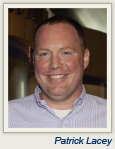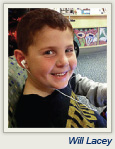

After experiencing the loss of my wife Dina’s first pregnancy during her second trimester, we naturally worried that something would go wrong when she became pregnant again. But when our son Will was delivered at full term, we thought we could finally relax. Born at a whopping 10 lb, Will seemed by all measures a healthy, vibrant infant. A slightly drooping left eyelid and some swelling on the left side of his head were explained away as nothing more serious than baby fat. But as the months wore on and these symptoms persisted, Dina insisted that testing be done to rule out anything serious.
After blood test results proved inconclusive, an x-ray picked up an enlarged left supraclavicular lymph node and a sizable posterior mediastinal mass along his spinal column. Further testing confirmed a diagnosis of stage IV intermediate-risk neuroblastoma. The news was stunning. Our son was just 7 months old.
From Denial to Despair
Initially, Will’s prognosis seemed good. Our oncologist said that infants usually respond well to treatment and that Will’s survival odds were better than if he had been diagnosed when he was 18 months or older. The recommended front-line treatment was a brutal eight cycles of a combination of carboplatin, cyclophosphamide, doxorubicin, and etoposide. Although this regimen initially reduced his mediastinal tumor, by the end of the sixth cycle of treatment it was clear that he was no longer responding. Around this time, he underwent a resection of his primary tumor, which was interwoven on his brachial plexus. After finishing up the last two cycles of chemotherapy, we were told to come back in 3 months for a new set of CT scans. It turned out that those 3 months were the only time Will has been off therapy.
When Will was first diagnosed, I was in denial because I couldn’t conceive of the fact that my child has cancer, especially one as deadly as neuroblastoma. But I thought, he’s not like anyone else—we’ll do the treatment and get past this crisis, and the nonstop fog of pain and grief will be just a bad memory. But it didn’t turn out that way.
Over the next 2 years, Will underwent numerous cycles of chemotherapeutic regimens, including different combinations of cyclophosphamide, topotecan, cisplatin, etoposide, doxorubicin, vincristine, dactinomycin, ifosfamide, prednisone, MIBG radiotherapy, and ABT-751. The therapies caused uncontrollable violent vomiting, mouth sores, diaper rash, and pain. Because Will was so young when his treatments began, there was no way of explaining to him what was happening. All we could do was comfort him, sleep by his crib, and change his sheets after each vomiting episode.
Since Will’s immune system was so compromised, we wouldn’t allow visitors to the house, terrified that an infection would kill him. And even if by some miracle Will survived, we wondered what the long-term effects of his treatments might be: sterility, secondary cancers, heart disease, neurologic problems? He already has some hearing loss. As I watched him suffer from his therapies, all I could think was, “Is this really the best we can do?”
Working Together for a Cure
After 18 months of unsuccessful treatment, our doctors told us we had exhausted all curative options and that we could take Will home and keep him comfortable with palliative care. But we weren’t ready to give up. I searched the Internet for online communities of parents of children with neuroblastoma to see what they were doing and phoned specialists and researchers in neuroblastoma to find new treatments being investigated. I also cofounded the Friends of Will Foundation to raise money for research.
 All these efforts led me to Giselle Sholler, MD, Chair of the Neuroblastoma and Medulloblastoma Translational Research Consortium and Co-director of the Van Andel Research Institute’s Pediatric Cancer Translational Research Program in Grand Rapids, Michigan. Dr. Sholler offered us several therapies that stabilized Will’s cancer and improved his quality of life. Most recently, Will enrolled in a phase I study of one cycle of alpha-difluoromethylornithine (DFMO), followed by four cycles of DFMO combined with etoposide. At the end of the study, Will’s disease remained stable, and he continues to take DFMO as a single agent.
All these efforts led me to Giselle Sholler, MD, Chair of the Neuroblastoma and Medulloblastoma Translational Research Consortium and Co-director of the Van Andel Research Institute’s Pediatric Cancer Translational Research Program in Grand Rapids, Michigan. Dr. Sholler offered us several therapies that stabilized Will’s cancer and improved his quality of life. Most recently, Will enrolled in a phase I study of one cycle of alpha-difluoromethylornithine (DFMO), followed by four cycles of DFMO combined with etoposide. At the end of the study, Will’s disease remained stable, and he continues to take DFMO as a single agent.
Now age 7, Will is finally living a somewhat normal childhood. He has no side effects from his current therapy and was able to complete first grade without missing a day of school. But I’m not naive. I understand the realities of his disease. I’m just saying that while a cure for neuroblastoma may not be the reality today, it doesn’t mean it won’t be the reality tomorrow.
I don’t want physicians to fear giving parents hope. We just want to believe that with parents, clinicians, and researchers working together, a change in the course of neuroblastoma is possible. We just want a chance at a rational therapy to save our kids. ■
Patrick Lacey is a business manager for a leading information company in Boston and the cofounder and President of the Friends of Will Foundation (Beatnb.org).

